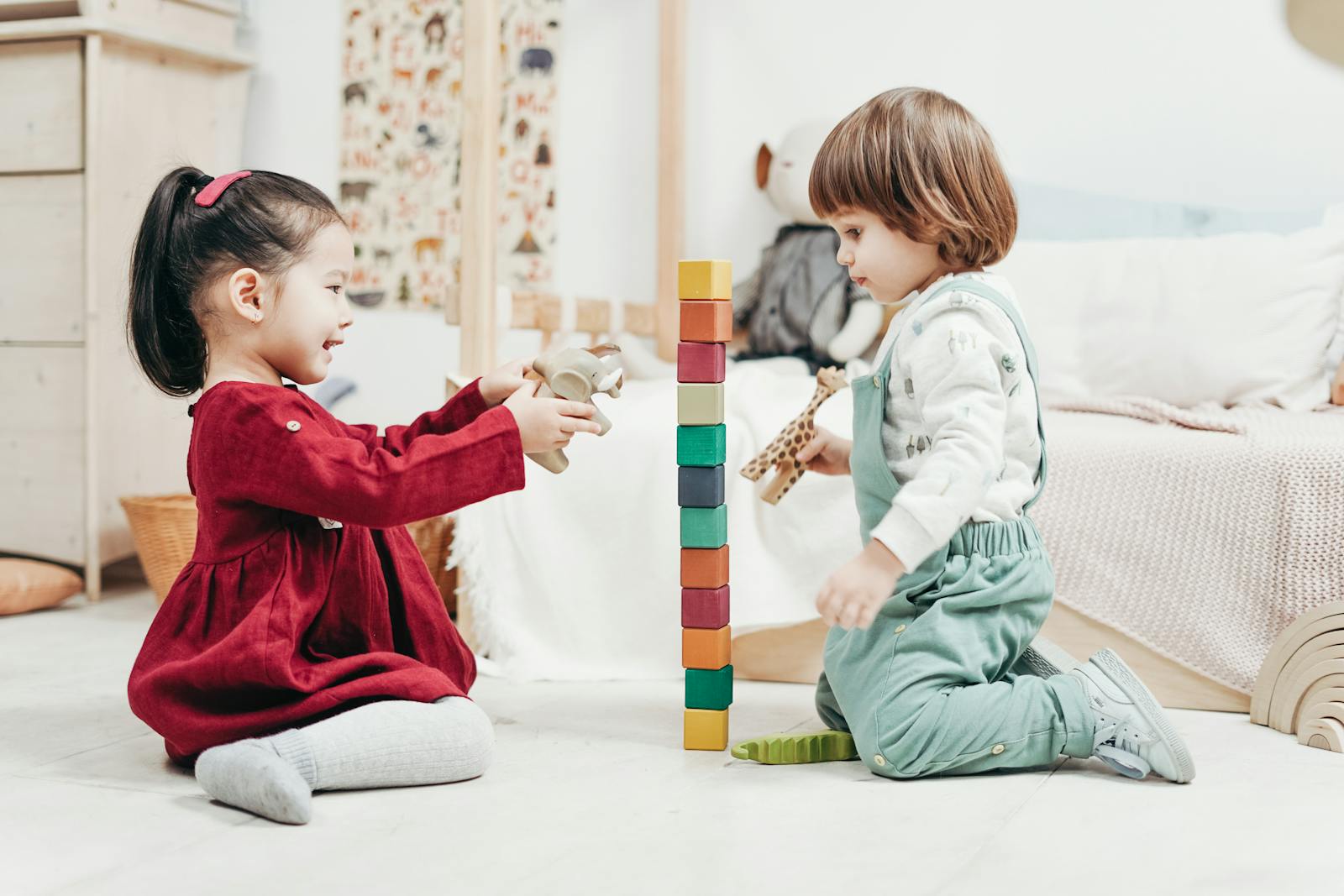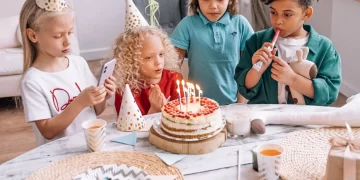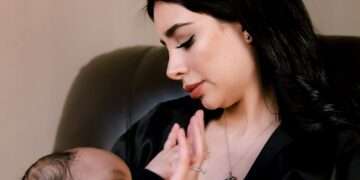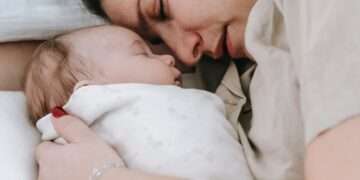
Children are little explorers who learn by doing. Play gives your child a great opportunity to develop and practice new skills at her own pace by following her unique interests. The toys and playthings your child has available to her can shape her development in important ways.
While it may seem like choosing toys for children should be easy, as you walk into a toy store today, the only thing that’s easy is feeling overwhelmed. There is a huge array of toys that have been developed for the toddler market. How do you choose which is right for your child? How can you tell which are high quality and which will last? Which will engage your child’s interest for more than a few days or weeks? Here are some ideas for choosing toys that will grow with your child, challenge her, and nurture her overall development (her thinking, physical, language, and social-emotional skills).
Guidelines for Choosing Toys for Your Child
Choose toys that can be used in a variety of ways.
Toddlers love to take apart, put back together, pull out, put in, add on, and build up. Choose toys that are “open-ended” in the sense that your child can play many different games with them. For example, wooden blocks or chunky plastic interlocking blocks can be used to make a road, a zoo, a bridge, or a spaceship. Toys like this spark your child’s imagination and help him develop problem-solving and logical thinking skills.
Look for toys that will grow with your child.
We all have had the experience of buying a toy that our child plays with for two days and never touches again. You can guard against that by looking for toys that can be fun at different developmental stages. For example, small plastic animals are fun for a young toddler who may make a shoebox house for them, while an older toddler can use them to act out a story she makes up.
Select toys that encourage exploration and problem-solving.
Play gives children the chance to practice new skills over and over again. Toys that give kids a chance to figure something out on their own—or with a little coaching—build their logical thinking skills and help them become persistent problem-solvers. They also help children develop spatial relations skills (understanding how things fit together), hand-eye coordination, and fine motor skills (using the small muscles in the hands and fingers).
Look for toys that spark your child’s imagination.
During your child’s third year, his creativity is really taking off as he is now able to take on the role of someone else (like a king) and imagine that something (like a block) is actually something else (like a piece of cake). Look for toys that your child can use as he develops and acts out stories. Pretend play builds language and literacy skills, problem-solving skills, and the ability to sequence (put events in a logical order).
Give your child the chance to play with “real” stuff—or toys that look like the real thing.
Your toddler is getting good at figuring out how objects in her world work—like television remotes or light switches. She is also interested in playing with your “real” stuff, like your cell phone, because she is eager to be big and capable like you. Toys like this help children problem-solve, learn spatial relations (how things fit together), and develop fine motor skills (use of the small muscles in the hands and fingers).
Toss in some “getting ready to read” toys.
Books, magnetic alphabet letters, and art supplies like markers, crayons, and fingerpaints help your child develop early writing and reading skills. “Real-life” props like take-out menus, catalogs, or magazines are fun for your child to look at and play with and also build familiarity with letters, text, and print.
Seek out toys that encourage your child to be active.
Toddlers are doing all kinds of physical tricks as they are stronger and more confident with their bodies. Your job is to be an appreciative audience for your little one’s newest playground achievement! Look for toys that help your child practice current physical skills and develop new ones.
Look for toys that nurture cross-generational play.
While adults and children can play almost anything together, there are some baby toys that are designed for adult participation. As your child approaches age 3 and beyond, early board games—that involve using one’s memory or simple board games that do not require reading—are fun for all ages to play. Consider starting a “family game night” when all of you play together. Board games encourage counting, matching, and memory skills, as well as listening skills and self-control (as children learn to follow the rules). They also nurture language and relationship-building skills. Another important benefit is teaching children to be gracious winners and how to cope with losing.
Here are some tips to help you select toys that are not only entertaining but also beneficial for your child’s growth and development:
The first time you can look through the toy department you may be struck by how much more expensive toys are today than you remembered. Toys don’t have to be expensive, though. And with toys, expense has nothing to do with quality.
A good toy for one child isn’t necessarily a good toy for another child. When you purchase a toy, you need to consider your child’s personality, likes, and dislikes. In this article, we will answer all of your toy questions, including:
Children’s Toy Safety
Every year hundreds of thousands of children get injured playing with their friends and family have bought for them. Though there are manufacturer standards, your child’s play needs to be further inspected by you for safety. In this section, we will give a list of safety concerns that you should consider before you bring a toy home for your child. From shocks to choking, to burning, we will show you the hazards you need to look out for.
Before buying a toy, consider the following aspects of its construction:
- Strong construction: Try to pull off eyes, buttons, parts, pieces, and ornaments to be sure a small child cannot pull them off and choke on them.
- Fragility: Make sure the play won’t shatter if it is dropped or thrown onto a hard surface from a child’s height.
- Paints: Must be painted with non-toxic paints, but antiques or hand-me-downs may not be coated with safe paint.
- Cloth and stuffing: These should be flame-resistant.
- Sharp or pointed edges: Run your fingers over metal or plastic pieces to see if they cut or scratch. File down any sharp ridges on molded plastics. On wood toys, be sure no edges are splintering. Be sure there are no points or propelling objects that could cause eye or puncture injuries.
- Stability of sitting toys: Place these large toys on the floor and try to push them over. They should be broad-based for stability.
- Nonelectric: Avoid electric toys for toddlers since they may attempt to eat batteries or they may get hurt while attempting to plug in or unplug the toy. Toys that have heating elements are unsafe for children younger than eight years old.
- Hardware: Make sure the hardware is not rough and does not have a scissoring action that could pinch.
- Noise: Activate toys that make noise and be sure they won’t damage hearing if babies hold them close to their ears. Avoid any toy that emits a continuous, loud pure tone; such a noise can damage the ears. Teach your child to keep all noise-making toys away from her ears. Toy guns (which many parents avoid on general principles) can cause ear damage even when used properly.
- Parts: Make sure the toy has no parts small enough for a child to ingest. Be sure any moving parts are securely enclosed.
- Strangulation dangers: Ropes or strings on toys should be no longer than 12 inches and loops should not be big enough to fit around a child’s neck.
When selecting outdoor play equipment, purchase equipment appropriate for your child’s age and size. There should be no rough edges or exposed hardware. Make sure these toys are assembled properly, according to the manufacturer’s instructions.
Place swings at least six feet from houses, trees, and other obstructions, and set them on soft surfaces, not concrete. Fill sandboxes with fresh, clean sand, and cover them when not in use. Sandboxes are not recommended for children in the “taste-everything” stage of development. For reasons of sanitation, keep pets away from the sandbox.
Toys for children of different ages
Many toys have age-range information on their packaging. This can be useful, but it’s only a guide for play. Your child’s interests will give you a better idea of what to choose. Here are ideas to interest children of different ages.
Generally speaking, a good toy should challenge a child at his high level of development. If it’s too sophisticated, it frustrates the child; if it’s too simple, it bores the child. So it’s important to observe the age ranges on packages.
Infants: Birth to 1 Year
One of the major safety concerns during this period is choking and suffocation.
Make sure stuffed toys are nonflammable, non-toxic, and washable. Stuffed animals that are all one piece are best; any limbs should be securely attached. It features should be painted or embroidered, and it should not have embellishments, such as glass eyes or whiskers, which children can pull off and swallow.
Mobiles can help develop a baby’s ability to focus attention on objects, but they are meant to be looked at only — not handled. Once your child is old enough to reach up and grab the mobile (usually at about four to five months), remove it.
Rattles and teething rings must be unbreakable and washable, have no loose parts, and have rounded stems. No part of a rattle should be small enough to fit in a baby’s mouth. To test this, draw an oval that is 1 3/8 inches x 2 inches on a piece of paper and cut it out. If the rattle or any part of it can pass through the hole to a depth of 1 3/16 inches or more, the rattle could choke your child. You can purchase rattles in a variety of shapes, sizes, and colors. Be sure the size and weight are compatible with your child’s ability to grasp it in one hand.
Crib and playpen exercisers usually stretch across the crib or playpen and enhance pulling and grasping. Remove them before babies are big enough to use them to pull themselves up.
Special balls that make noise and have moving pieces inside provide motor, visual, and aural stimulation and help develop eye movement, crawling, and gross motor skills. Be sure your child cannot remove the moving pieces from the ball.
Mirrors delight infants. But make sure they are unbreakable, have no sharp edges, are light enough for your baby to pick up, and are large enough not to be swallowed.
Toddlers: 12 to 18 Months
At this point, children can stand and sit but may not yet walk by themselves. They can enjoy moving objects, such as push-pull toys that make sounds, that open and close and involve turning knobs and dials, and peek-a-boo games.
At this age, children enjoy blocks, but be sure to get large blocks that have no sharp corners. Just a few blocks will suffice; too many confuse a baby. Blocks covered with soft fabric and light, foam-filled vinyl blocks are ideal.
Sorting toys teach children about color and size and enhances manual dexterity, but can make sure they are unbreakable and pieces are too large for your child to swallow.
Riding toys is dangerous for your children who can’t yet walk. But children who can walk enjoy them.
Make sure your child can climb on and off the toy easily and maneuver it alone. Also, can make sure it has no sharp edges.
Push-pull toys are great for kids who are already walking, too. Make sure the ends of the handles are covered with large safety balls and all the parts are unbreakable.
Toddlers: 18 to 24 Months
Children at this age are talking and are interested in learning about size and placement.
Large blocks in a variety of shapes interest children at this age. Start out with a small set and move on to a large set as the child’s interest develops. Avoid blocks with sharp edges. Blocks that come in canisters are easiest for a child to put away when play is through. Blocks are a good investment; they hold children’s interest for a long time. They are usually appropriate from the age of 18 months to 8 years.
Telephones give children an opportunity to engage in an adult activity, and children like the noise they make. Those shaped like cartoon characters help maintain interest. Be sure bell parts cannot be removed and swallowed.
Baby Shape-recognition toys that require children to fit pieces in appropriately shaped holes help develop hand-eye coordination, matching skills, and shape recognition. However, if the toy has too many pieces, the child will be frustrated. Watch for pieces of swallowable size and holes that can pinch or trap fingers.
Action toys, such as a push-pull bus with removable people, are very popular with children at this age, as are push-pull train sets with removable accessories. Make sure all parts are swallow-proof.
Pounding toys can teach hand-eye coordination and enhance gross and fine motor skills. Any hammer should be very soft, so the child isn’t injured by it.
Riding toys come in two types: those the child moves by pushing with her feet and those with pedals. The latter are more difficult for children to use. All riding toys should be stable and easy to mount. They are usually appropriate for children 18 to 36 months of age. Always supervise a child using a riding toy outdoors, particularly near sidewalks or streets.
Activity toys are those that children either crawl or climb on or use to develop manual dexterity. Climbing toys should have railings and other safety features. It enhances dexterity and should be suited to your child’s abilities; they should challenging but not frustrating.
Toddlers: 2 to 3 Years
At this point, children are more creative and develop new skills. They can make-believe and fantasy in their play. Their attention spans are longer. They enjoy adult-like activities, and realistic toys stimulate hours of creative play. This age group enjoys toys that require movement as well as those that involve dexterity.
Talking toys and dolls are very appealing. Make sure the dolls speak their phrases clearly, and the pull ring is securely attached.
Toy dashboards are popular, too. The more features the dashboard has, the more interest the child has in it. Just make sure it’s easy to use. Avoid toys with knobs or decals the child can easily pull off.
Trucks are good toys for indoors and outdoors, especially for the sandbox. Trucks that have moving parts are especially appealing, but be sure there are no sharp edges and the metal is rust-proof. Choose trucks that are stable and maneuverable with wheels securely attached.
Push or wind-up trains are popular. Your child should be able to easily place the train on its tracks, though an adult usually needs to assemble the tracks. Make sure wind-up mechanisms are easy to use, and avoid toys with sharp edges.
Check for the durability of toy kitchens and realistic tool toys. Make sure these toys are manageable for your child, or they won’t sustain interest. Also, be sure that large items are stable and won’t fall on your child during play. Tool benches should provide a variety of activities without being overwhelming.
Puzzles can be an excellent purchase. They strengthen hand-eye coordination, matching skills, and shape recognition, and sustain interest if matched to your child’s skill level. Puzzles suitable for all ages are available. Pieces should not be so small as to encourage your child to pop them in his mouth.
Play scenes provide a child with the opportunity to use her imagination. These toys often have more appeal if the scenes are familiar, so a city child may enjoy a toy parking garage more than a farm scene. (Then again, the farm scene might be an excellent way to introduce your city child to life on a farm.) The toys should be easy to assemble, have storage for individual pieces, and have moving features. Also, be sure your child isn’t overwhelmed by a multitude of pieces.
Baby Occupation toys, such as a doctor’s kit, inspire creative play. A child familiar with the occupation it represents will appreciate the toy.
Conclusion: When choosing a toy for a child your first concern should be that it is safe. But, apart from just not causing harm, toys can also help your child grow and develop. A child’s play is vitally important to their creativity and imagination. Toys are a vital part of any child’s life. They can be used for learning and to teach children about the world around them.
If you’re like most parents and want to make sure your kids have the best toys. But with so many options available, it can be tough to know which ones to choose. Not to worry – here are some tips to help you select the best toys for your kids. Some of the best toys are age-appropriate and benefit your kid in multiple ways. Make sure to choose toys that are appropriate for your child’s age, interests, and abilities.
































